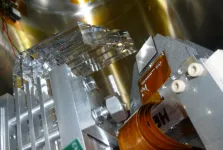(Press-News.org) MALVERN, Pa. -- Doctors and healthcare workers may one day use a machine learning model, called deep learning, to guide their treatment decisions for lung cancer patients, according to a team of Penn State Great Valley researchers.
In a study, the researchers report that they developed a deep learning model that, in certain conditions, was more than 71 percent accurate in predicting survival expectancy of lung cancer patients, significantly better than traditional machine learning models that the team tested. The other machine learning models the team tested had about a 61 percent accuracy rate.
Information on a patient's survival expectancy could help guide doctors and caregivers in making better decisions on using medicines, allocating resources and determining the intensity of care for patients, according to Youakim Badr, associate professor of data analytics.
"This is a high-performance system that is highly accurate and is aimed at helping doctors make these important decisions about providing care to their patients," said Badr. "Of course, this tool can't be used as a substitute for a doctor in making decisions on lung cancer treatments."
According to Robin G. Qiu, professor of information science and engineering and an affiliate of the Institute for Computational and Data Sciences, the model can analyze a large amount of data, typically called features in machine learning, that describe the patients and the disease to understand how a combination of factors affect lung cancer survival periods. Features can include information such as types of cancer, size of tumors, the speed of tumor growth and demographic data.
Deep learning may be uniquely suited to tackle lung cancer prognosis because the model can provide the robust analysis necessary in cancer research, according to the researchers, who report their findings in International Journal of Medical Informatics. Deep learning is a type of machine learning that is based on artificial neural networks, which are generally modelled on how the human brain's own neural network functions.
In deep learning, however, developers apply a sophisticated structure of multiple layers of these artificial neurons, which is why the model is referred to as "deep." The learning aspect of deep learning comes from how the system learns from connections between data and labels, said Badr.
"Deep learning is a machine-learning algorithm that makes associations between the data, itself, and the labels that we use to describe the data examples," said Badr. "By making these associations, it learns from the data."
Qiu added that deep learning's structure offers several advantages for many data science tasks, especially when confronted with data sets that have a large number of records -- in this case, patients -- as well as a large number of features.
"It improves performance tremendously," said Qiu. "In deep learning we can go deeper, which is why they call it that. In traditional machine learning, you have a simple structure of layers of neural networks. In each layer, you have a group of cells. In deep learning, there are many layers of these cells that can be architected into a sophisticated structure to perform better feature transformation and extraction, which gives you the ability to further improve the accuracy of any model."
In the future, the researchers would like to improve the model and test its ability to analyze other types of cancers and medical conditions.
"The accuracy rate is good so far -- but it's not perfect, so part of our future work is to improve the model," said Qiu.
To further improve their deep learning model, the researchers would also need to connect with domain experts, who are people who have specific knowledge. In this case, the researchers would like to connect with experts on specific cancers and medical conditions.
"In a lot of cases, we might not know a lot of features that should go into the model," said Qiu. "But, by collaborating with domain experts, they could help us collect important features about patients that we might not be aware of and that would further improve the model."
The researchers analyzed data from the Surveillance, Epidemiology, and End Results (SEER) program. The SEER dataset is one of the biggest and most comprehensive databases on the early diagnosis information for cancer patients in the United States, according to Shreyesh Doppalapudi, a graduate student research assistant and first author of the paper. The program's cancer registries cover almost 35 percent of the U.S. cancer patients.
"One of the really good things about this data is that it covers a large section of the population and it's really diverse," said Doppalapudi. "Another good thing is that it covers a lot of different features, which you can use for many different purposes. This becomes very valuable, especially when using machine learning approaches."
Doppalapudi added that the team compared several deep learning approaches, including artificial neural networks, convolutional neural networks and recurrent neural networks, to traditional machine learning models. The deep learning approaches performed much better than the traditional machine learning methods, he said.
Deep learning architecture is better suited to processing such large, diverse datasets, such as the SEER program, according to Doppalapudi. Working on these types of datasets requires robust computational capacity. In this study, the researchers relied on ICDS's Roar supercomputer.
With about 800,000 to 900,000 entries in the SEER dataset, the researchers said that manually finding these associations in the data with an entire team of medical researchers would be extremely difficult without assistance from machine learning.
"If it were just three fields, I would say it would be impossible, but, we had about 150 fields," said Doppalapudi. "Understanding all of those different fields and then reading and learning from that information, would just be near impossible."
INFORMATION:
HOUSTON -- The first randomized Phase II clinical trial to report on single and combined neoadjuvant immune checkpoint inhibitor therapy in stage I-III non-small cell lung cancer (NSCLC) found combination therapy produced a significant clinical benefit, as assessed by major pathologic response (MPR) rate, as well as enhanced tumor immune cell infiltration and immunological memory. Researchers from The University of Texas MD Anderson Cancer Center published the study results today in Nature Medicine.
The NEOSTAR trial tested combined neoadjuvant therapy of nivolumab plus ipilimumab, as well as neoadjuvant nivolumab monotherapy in patients with operable NSCLC. The trial met its prespecified primary endpoint efficacy threshold in ...
Throughout nature, there are instances of animals aiding one another and living together in mutually beneficial relationships that have helped shape the world's landscapes and biodiversity.
These domesticator-domesticate relationships form when one species provides multigenerational support to another species in exchange for a resource or service that benefits both species. An example of this type of relationship is how early humans domesticated gray wolves. The wolves were attracted to the human encampments, which provided them with protection and resources, and the wolves, in turn, helped the humans increase their hunting proficiency.
One area ...
Richer countries were more likely to see rates of COVID-19 fall faster during the first wave of the pandemic, according to new research published in the journal Frontiers in Public Health.
The study by Anglia Ruskin University (ARU) professors Shahina Pardhan and Nick Drydakis examined economic indicators in 38 European countries, such as Gross Domestic Product (GDP) per capita, life expectancy, and public spending, and the number of new coronavirus cases per million of the population between 1 April and 31 May 2020, using data from Our World in Data based on the seven-day rolling average of new cases for each country.
A significant negative correlation ...
UCLA RESEARCH ALERT
FINDINGS
UCLA Jonsson Comprehensive Cancer Center researchers have uncovered a potential new way to target pancreatic tumors that express high intratumoral interferon signaling (IFN). The team found that high type I IFN signaling is present in a subset of pancreatic tumors and it triggers a decrease in the level of NAD and NADH in pancreatic cancer cells, which are vital cofactors in critical metabolic processes.
After the researchers delineated the mechanism by which the NAD depletion occurs, they demonstrated that cells with high IFN signaling were more sensitive to NAMPT inhibitors, which inhibit a major pathway ...
NEW YORK, NY (Feb. 18, 2021)--A research team at the Center of Prevention and Evaluation (COPE) at Columbia University Irving Medical Center and the New York State Psychiatric Institute, led by Drs. Gary Brucato and Ragy R. Girgis, found that, contrary to popular belief, serious mental illness was present in only 11% of all mass murderers and in only 8% of mass shooters.
The study--the first published report on mass shootings from the Columbia Mass Murder Database--appeared online Feb. 17th in Psychological Medicine.
The investigators sought to gain much-needed insight into the relationship between serious mental ...
As climate change takes hold across the Americas, some areas will get wetter, and others will get hotter and drier. A new study of the yellow warbler, a widespread migratory songbird, shows that individuals have the same climatic preferences across their migratory range. The work is published Feb. 17 in Ecology Letters.
"What's amazing is that the birds track similar climates despite the fact that they have migrated thousands of miles," said Rachael Bay, assistant professor in the Department of Evolution and Ecology, College of Biological Sciences at the University of California, Davis. "It seems that individual birds may be adapted to particular ...
An international study in which the University of Granada participated--recently published in the journal Scientific Reports--has identified a new fossil record of these mysterious animals in the northeast of Taiwan (China), in marine sediments from the Miocene Age (between 23 and 5.3 million years ago)
These organisms, similar to today's Bobbit worm (Eunice aphroditois), were approximately 2 m long and 3 cm in diameter and lived in burrows
An international study in which the University of Granada (UGR) participated (recently published in the prestigious journal Scientific Reports) has revealed that the seafloor was inhabited by giant predatory worms during the Miocene Age (23-5.3 million years ...
Hip dysplasia is a developmental disorder common in most dog breeds, and its onset is affected by both hereditary and environmental factors.
Prior studies have identified dozens of genetic loci associated with hip dysplasia in various breeds. The relevance of the loci to disease susceptibility remains an open question. The previously identified loci were reinvestigated at the University of Helsinki, Finland, using a large independent cohort of 1,600 dogs representing ten breeds.
The individual genetic variants at the target loci were determined from blood samples. The standardized ...
While most adults over 50 understand that overuse of antibiotics is a problem, and say they're cautious about taking the drugs, a sizable minority have used antibiotics for something other than their original purpose, and appear to think the drugs could help treat colds, which are caused by viruses not bacteria.
These findings, contained in a new paper in Infection Control and Hospital Epidemiology, come from a national poll of people between the ages of 50 and 80 carried out as part of the National Poll on Healthy Aging.
The authors, from the University of ...
Cracow, 18 February 2021
Creation of matter in an interaction of two photons belongs to a class of very rare phenomena. From the data of the ATLAS experiment at the LHC, collected with the new AFP proton detectors at the highest energies available to-date, a more accurate - and more interesting - picture of the phenomena occurring during photon collisions is emerging.
If you point a glowing flashlight towards another one, you do not expect any spectacular phenomena. The photons emitted by both flashlights simply pass by each other. However, in certain collisions involving high-energy protons the situation is different. The ...





